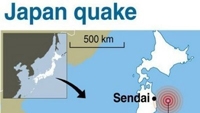Japanese crisis threatens global shortage of electronic components

Japan survived a massive earthquake and resulting tsunami, but the nuclear crisis and its unpredictable aftermath will be ominously looming in the days, and weeks, ahead. As engineers struggle to contain the damage at the Fukushima nuclear plant to avert a nuclear disaster, Japan’s economy is also facing a possible meltdown.
About 20 percent of all semiconductors and 40 percent of all flash memory chips in the world are made in Japan. A nuclear disaster may not only cost lives but could also have a global impact on the electronics made with these components, including those found in TV broadcast equipment and the computers that support broadcasters.
Explosions at the nuclear plants at the Fukushima Daiichi nuclear power station have already made the crisis the worst nuclear accident since the Chernobyl reactor disaster a quarter-century ago.
“It’s way past Three Mile Island already,” Frank von Hippel, a physicist and professor at Princeton, told The New York Times. “The biggest risk now is that the core really melts down and you have a steam explosion.”
What’s ahead, as the crisis deepens, is unknown and changing by the hour.
Major manufacturers of professional equipment, including Canon (camcorders and lenses), FOR-A (switchers, monitors, signal processors, etc.), Fujinon (lenses), Grass Valley (editing software), Panasonic (cameras, switchers, monitors, solid-state memory, etc.) and Sony (cameras, switchers, monitors, solid-state memory, etc.), have all been affected in some way. Everyone is coping as best they can.
A series of well-planned rolling blackouts throughout the country have certainly curtailed production schedules, but none of the companies contacted were able to predict how it would affect product shipments or the upcoming NAB Show in Las Vegas in April.
The professional video industry's #1 source for news, trends and product and tech information. Sign up below.
Sony, the nation’s largest electronics exporter, shut down six factories throughout the country last week and two so far this week. One of those factories, in Sendai, where Sony’s video tape and data media products are made, was hit by the tsunami. As to the extent of the damage to that facility, Alec Shapiro, Sony senior vice president of sales and marketing of professional solutions for America, said in an e-mail that it was “too early to tell.”
A spokesperson for Grass Valley said its EDIUS HD editing software and other related products, including the HD Thunder acceleration board, are manufactured in two locations in Japan: one in the southern city of Kobe, which was unaffected, and another in Tokyo, which sustained limited damage. It “is still operational and all of our employees and their families are fine,” the spokesperson said.
Canon U.S.A. president and CEO Joe Adachi provided some details on Canon’s main broadcast lens facility in Tokyo, approximately 200mi from the epicenter, in an email: “At this time, preliminary reports are that there have been a limited amount of injuries at our Utsunomiya Office, located in Tochigi prefecture, and there has been a limited amount of damage to our facilities. Our colleagues and extended families in Japan are very much in our thoughts and we will support them in any way that we can.”
Fujifilm Optical Devices, makers of Fujinon broadcast and security lenses, maintains two facilities: one in Omiya, outside Tokyo, and the other in Mito. The latter was without power as of Tuesday. Gordon Tubbs, director of sales in the United States, said both buildings sustained minor damage (cracks in the wall) but were trying to maintain some type of production schedule. All employees are safe and have been accounted for.
Panasonic has three manufacturing plants in Sendai, the largest city in the area, and Fukushima, near the epicenter of the earthquake. Although the company would not comment publicly, it has been reported that several employees had minor injuries at the three plans, but there were no deaths or severe injuries. Those plants manufacture components for digital cameras, audio equipment, optical pickups for Blu-ray and DVD decks and other components.
In 2008, Panasonic opened a new EV Energy manufacturing plant in Sendai, which is 15.5mi from where the earthquake hit. That plant is believed to have been wiped out by the tsunami, according to news reports.
Hitachi closed six plants in northern Japan and is inspecting all of them. They make camcorders, plasma and LCD TVs, and DVD players. Texas Instruments lost two plants that make wafers and DLP chips. Reuters reported it will take until summer for Texas Instruments to come back online, pending further problems with the nuclear plants.
Sanyo, Sharp and Mitsubishi were also hit with plant shutdowns. Sharp’s new LED display factory in Sakai, which was built to withstand earthquakes, automatically shut down when the first shocks were felt.
Other consumer electronics companies, including Nikon (in Sendai), Nintendo, Olympus and Samsung, reported minimum damage from the earthquake and tsunami.
For everyone, the uncertainty of nuclear fallout could have long-lasting effects, impossible to predict or even fathom at this point.
